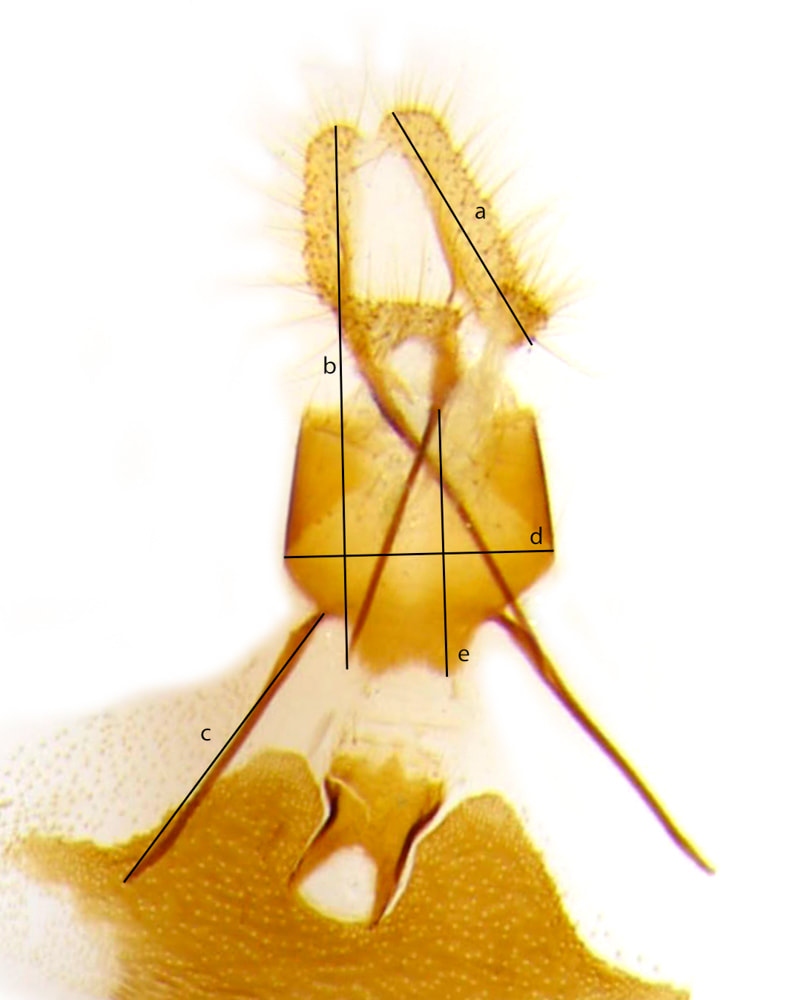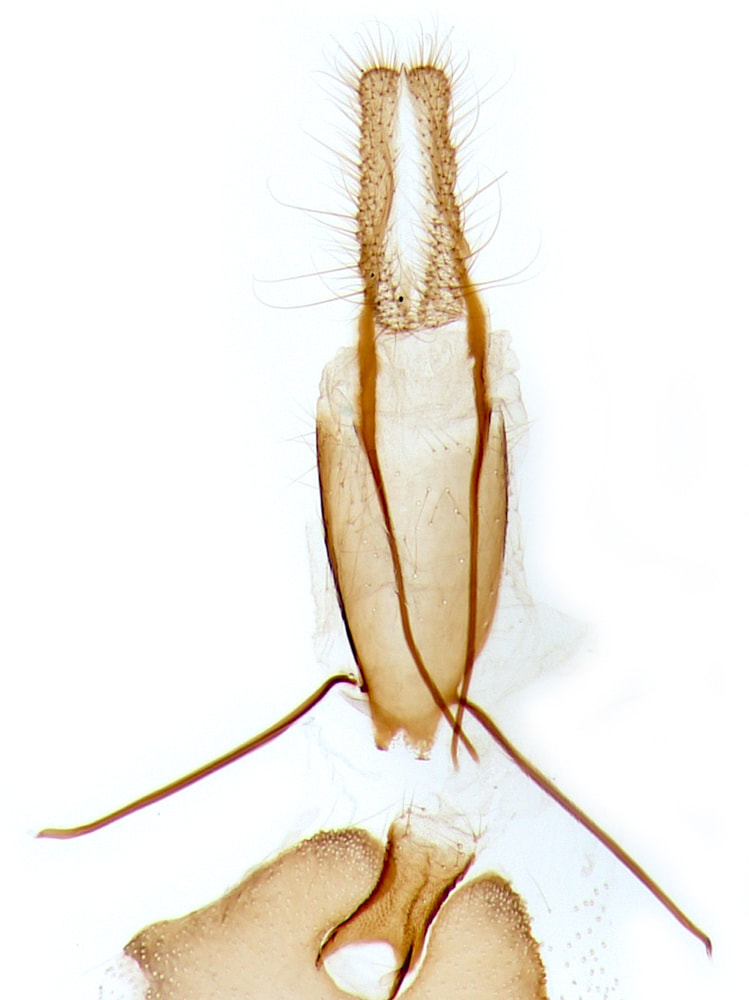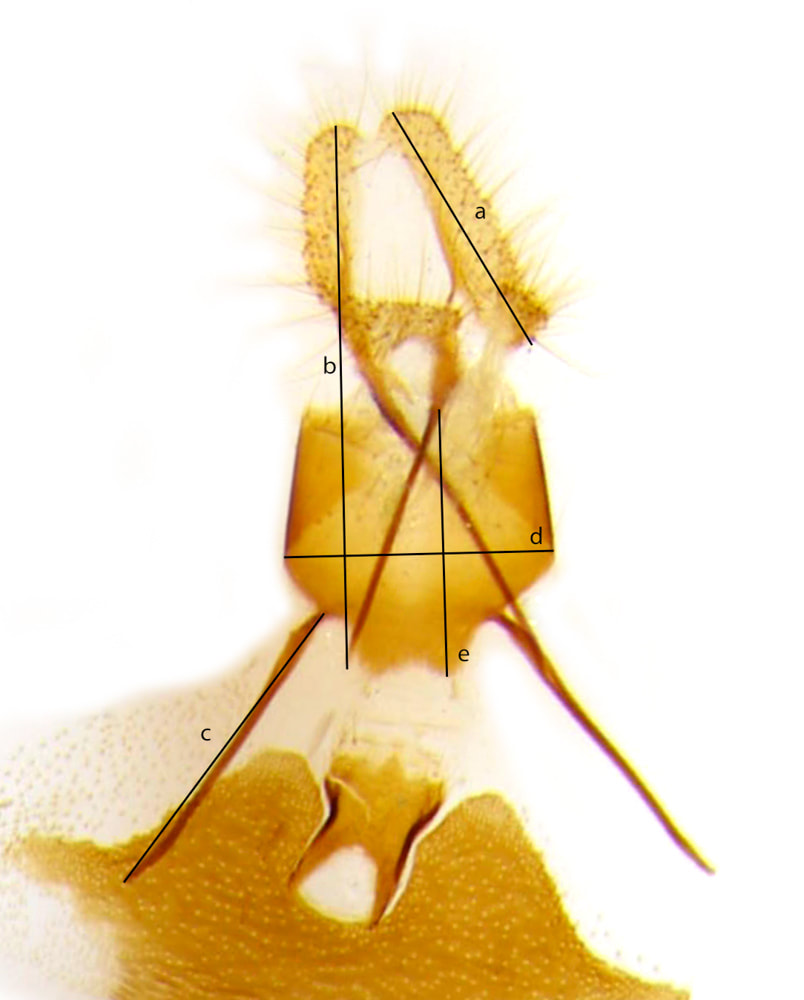Identification of Eucosma hohenwartiana / parvulana / fulvana
These three species, formerly all treated in Britain as E.hohenwartiana, were separated following publication of a paper in Nota Lepidopterologica by Agassiz & Langmaid (Nota lepidopterologica 27(1): 41-49) in 2004.
Summary
These 3 species may be reliably separated by examination of the female genitalia
There are no reliable differences in external morphology between these species, though size is helpful in separation of E.fulvana/parvulana.
Forewing colouration tends to be paler in E.fulvana than in E.hohenwartiana; and more uniform in E.parvulana than in E.hohenwartiana.
There are no consistent differences in the male genitalia which would allow confirmation of the identity of males.
Proximity to the larval foodplant may be a guide to identity.
E.hohenwartiana: ovipositor long and slender, 8th sternite elongate
E.fulvana: ovipositor less elongate, 8th sternite quadrate, wingspan >19mm
E.parvulana: ovipositor less elongate, 8th sternite quadrate, wingspan <19mm
These 3 species may be reliably separated by examination of the female genitalia
There are no reliable differences in external morphology between these species, though size is helpful in separation of E.fulvana/parvulana.
Forewing colouration tends to be paler in E.fulvana than in E.hohenwartiana; and more uniform in E.parvulana than in E.hohenwartiana.
There are no consistent differences in the male genitalia which would allow confirmation of the identity of males.
Proximity to the larval foodplant may be a guide to identity.
E.hohenwartiana: ovipositor long and slender, 8th sternite elongate
E.fulvana: ovipositor less elongate, 8th sternite quadrate, wingspan >19mm
E.parvulana: ovipositor less elongate, 8th sternite quadrate, wingspan <19mm
Size
E.fulvana and E.parvulana should be separable on size if the quoted size ranges are reliable. Unfortunately the size range quoted in what should be the most reliable recent guide - MBGBI5.2 - are quite different from those quoted in the Agassiz & Langmaid paper on which separation of the species is based. Despite the ranges quoted in MBGBI5.2, in its discussion of similar species under E.hohenwartiana, it uses a cut off of 19.5mm for separating E.fulvana from E.parvulana. This is clearly internally inconsistent, and implies that the ranges quoted in MBGBI5.2 are wrong, so I would propose to rely on the ranges quoted by Agassiz and Langmaid. The range quoted by BTM etc is likely to reflect a time when the 3 species were regarded as one.
E.fulvana and E.parvulana should be separable on size if the quoted size ranges are reliable. Unfortunately the size range quoted in what should be the most reliable recent guide - MBGBI5.2 - are quite different from those quoted in the Agassiz & Langmaid paper on which separation of the species is based. Despite the ranges quoted in MBGBI5.2, in its discussion of similar species under E.hohenwartiana, it uses a cut off of 19.5mm for separating E.fulvana from E.parvulana. This is clearly internally inconsistent, and implies that the ranges quoted in MBGBI5.2 are wrong, so I would propose to rely on the ranges quoted by Agassiz and Langmaid. The range quoted by BTM etc is likely to reflect a time when the 3 species were regarded as one.
SIZE (wingspan mm) |
MBGBI5.2 |
BTM, UKMoths & Norfolk Moths |
Agassiz & Langmaid Hants Moths |
E.hohenwartiana |
16-22 |
11-23 |
15-22 |
E.fulvana |
16-20 |
/ |
19-25 |
E.parvulana |
12-16 |
/ |
14-19 |
Larval foodplant
E.hohenwartiana |
Common Knapweed (Centaurea nigra) |
E.fulvana |
Greater Knapweed (Centaurea scabiosa) |
E.parvulana |
Saw-wort (Serratula tinctoria) |
Female genitalia
Agassiz & Langmaid |
ovipositor : anal papillae (b:a) |
ovipositor length (b) |
mean 8th sternite length (e) * |
E.hohenwartiana |
>2.4 |
/ |
0.57mm |
E.fulvana |
<2.4 |
>1mm |
0.49mm |
E.parvulana |
<2.4 |
<1mm |
0.39mm |
* ranges of 8th sternite length overlap, but only the mean is given in the Agassiz & Langmaid paper
Moth Dissection |
ovipositor : anterior apophysis (b:c) |
8th sternite length:width (e:d) * |
E.hohenwartiana |
=2 |
2 |
E.fulvana |
<2 |
<1 |
E.parvulana |
<2 |
1 |
* width of 8th sternite (d) will vary with the degree of compression of the preparation, so this ratio is unlikely to be conclusive in separation of E.fulvana/parvulana
Page published 28/11/2017 | text modified 05/08/2018 to correct error (8th sternite had been referred to as sterigma)



